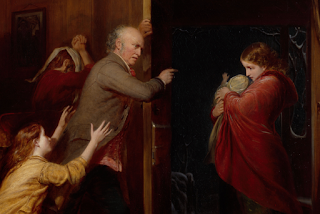Painting after performance @ Tate (Visit 2)
I decided to approach my second viewing of the Tate's Painting after performance exhibition with the following questions in mind:
- How is it curated; what is the sensation of this?
- What is it full of?
- What is the timeframe; is this an important feature of the show?
Formally, it is a show divided into two parts. The first looks at the "agitated" relationship shared by painting and performance (exhibition guide) for the period from the 1950s to the early 1980s and the second considers the late 1970s to the present day to show how contemporary art has been influenced by practitioners of the first period. Since the 1950s artists have discovered a new range of possibilities in light of advances in performance; there is an indissoluble link between performance and theatricality, but we are not talking only of the theatre, but of action too. What I ultimately emerged with was the impression that 20th-century art has been inspired and sustained by action, by performance. This is the statement of the show, and the timeframe in its longue durée does help to show the plausibility of the thesis. To continue this discussion of the curating it is useful to begin answering the second of my questions.
The parting memory I have is of being included in the show, which underscores its participatory element. Collaboration and participation are key ideas brought to the fore here, and closing with the large trompe l'oeil installations of Lucy McKenzie achieves this well as you walk through what we must imagine is a scale replica of the rooms in the 1963 novella Girls of Slender Means. One's knowledge of the exhibition and of contemporary art that would prioritise the making-process of art over the made-product is derived from feeling more than learning, then. These installations are shown next to photographs of ABRACADABRA featuring McKenzie's set pieces, which is a useful juxtaposition that intensifies the realism of effect I think she has attempted and the theatricality of contemporary art while offering a final example of the curators' zeal to demonstrate the many media of international artistic practice since the 1950s. This vast exhibition of contemporary and modern 20th-century art displays painting in the traditional canvas-bound sense with that practice upon supports that defy the frame; videos to be shown on a screen exist with videos to be projected upon canvases; still photography proper complements paint-enhanced photographs; videos of painting art and videos of painting as art sit in close company; sculptures punctuate the spaces and space itself becomes part of the art. All this fills the 12 rooms, emphasising process, which comes to occupy centre stage as the made of art bows out. The sensation is of artists as committed social practitioners.
A sense of energy and productivity is accompanied by perplexity and horror, however, as the Viennese Actionists have left me disturbed, particularly Nitsch. Two photographs of artistic performance participants covered in the blood of a sacrificial goat (?) suspended dead above their naked bodies displaying out of its split gut a unique and systematic interior anatomy are horrific to behold. Participants in the background of the scene -- seemingly not part of the sacrificial performance -- accentuate this sad horror. I am referring to the man to the right of the frame staring nervously: can he not believe what he sees or does he wish he were not in the shot; is he anxious for the shot to be right? At this point I find the activity of historical interpretation to be most difficult to swallow. This way such images can be excused as part of art history, as a response to horror, or -- in the most banal of terms -- as a record of a consensual collaboration that is not supposed to provoke my kind of ethical reaction. To suppress the images would be to censor them, so I do not think I advocate that by sketching my reaction... They certainly aim to show the extent and diversity of the centrality of performance to 20th-century artistic practice.

Comments
Post a Comment